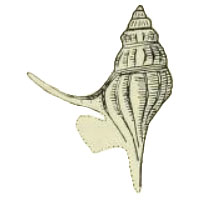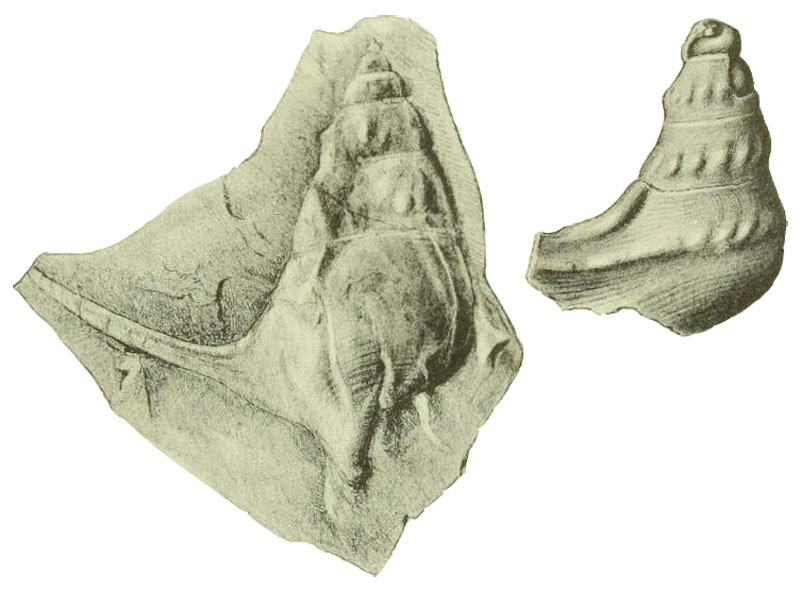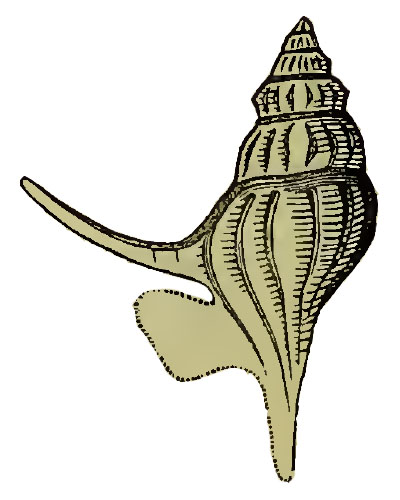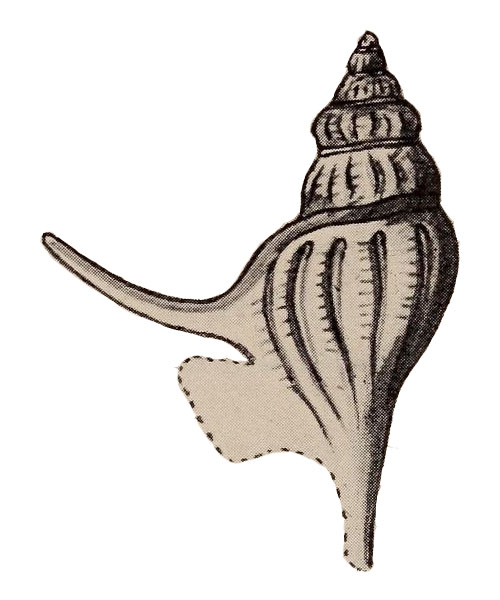|
edit SideBar
|
Species / Struthioptera Waiparaensis
Stromboidea
Hector. 1886 gave no description
Locus typicus / Stratum typicum: "Saurian beds, Waipara and Arnuri Bluff" (Hector, 1886, p. 58)
Rostellaria waiparensis Hector, 1886, p. 58, pl. 20, fig. 3
Comment Wieneke: original spelling is "waiparensis", which should be the correct spelling. But nearly all subsequent authors use "waiparaensis"
History and Synonymy
1914
Rostellaria waiparensis (Hector) in Chapman, 1914, pl. 101, fig. E
1922
About Perissoptera waiparaensis by Wilckens, 1922, p. 11:
- "Perissoptera Tate. Perissoptera waiparaensis (Hect. sp.) 0. Wilck. (Plate II, figs. 8, 9.)
- 1886. Rostellaria waiparaensis Hector, Catalogue of the Indian and Colonial Exhibition, London (Wellington, 1886), p. 58, fig. 20, No. .3.
- Description of Hector's Holotype (Plate II, fig. 8). — The presumed holotype of Hector is a crushed sculptured cast with remains of the shell. The shell consists of 9 (possibly more) whorls, 7 of which are preserved. The spire takes up about half of the whole shell. Although the shape and the sculpture are hardly perceptible on account of the damaged state of the specimen, one may notice that the whorls bear a spiral keel, formed by nodes, directed a little forward and below. Moreover, the whorls are spirally grooved. The body-whorl is inflated. Besides the keel, which is marked by nodes of medium strength, there still exists a lower spiral low-arched ridge. The last whorl is spirally sculptured down to the channel. The shell lies in the matrix with the aperture inside, so that this is not visible. The outer lip forms a long, curved, sabre-shaped digit, tapering towards its extremity. It probably has a position in continuation of the chief node-row, but in consequence of being crushed it now extends from about the middle of the body-whorl from below the knob-ridge. The top of the digit reaches nearly as high as the suture between the last and the penultimate whorl. The upper margin of the outer lip, according to the sabre shape of the digit, is largely sinuate and callously thickened. The digit curves not only upward but also backward. The channel is short, curved backward, and a little tortuous.
- Dimensions of the Holotype. — Height of the whole shell, 60 mm., of the spire, 27 mm.; breadth, measured from the top of the digit, 62 mm.
- Locality. — Loc. 9 (boulder beds. Saurian beds, east wing of Amuri Bluff).
- Remarks. — This specimen, marked on the label as the presumed holotype of Hector's figure, has never been described by Hector, and is figured in an insufficient manner (see fig. 1). Hector's restoration is erroneous in the number of the whorls, in the shape, and in the sculpture. Further, the channel is drawn too slender and the puctuate lobe of the outer lip does not exist.
 Wilckens, 1922, p. 11: "fig. 1 Hector's figure of Perissoptera waiparaensis"
- Supplement to the Description of the Species from the Remaining Material. — A second specimen from locality 9 is too damaged to give an idea of the general shape of the shell, but shows well the form and the sculpture of several whorls. There are 4 whorls preserved. The protoconch is missing. The sutures of the spire are slightly impressed. The whorls are decorated with knots a little oblique to the axis. On the penultimate whorl are 12 fine spiral ribs. On the body-whorl stand several strong nodes at unequal distances. In the continuation of this row of knots is a keel, continuing upon the wing. Below this knot-ridge the shell is a little concave, but farther below it is equally rounded. The surface of the whole body-whorl is decorated with a strong spiral sculpture. The preserved remains show that the wing of the outer lip forms a digit. The concave upper margin of the wing is thickened; this callosity, on the external surface, is accompanied by a furrow. The upper keel of the body-whoil, forming the continuation of the node-ridge, continues upon the wing of the outer lip. Below the digit the margin of the wing is a little sinuate. The lower part of the wing and the channel are broken away. A specimen from loc. 13 (Plate II, fig. 9), embedded in the rock-matrix, is a cast composed of calcite. It shows the body-whorl, with the wing much damaged, and two preceding whorls. The channel is sufficiently preserved to show the conformity with the holotype. It is broken, and undoubtedly was somewhat longer than it seems now. The nodes of the body-whorl are not very strong. Below the keel, formed by them, the shell shows a low arch. The spiral sculpture is well developed. The number of the spiral ribs on the last whorl and the channel is about 50. The growth-lines are very slight. The outer lip seems to be attached to the penultimate whorl — viz., to the lower two-thirds at least. The other specimens from loc. 13 show no essential differences from the features mentioned above, only the lower arch of tlie body-whorl is sometimes marked more distinctly. The spire is narrow-conical. The node-series of the whorls are situated immediately above the suture. The spiral sculpture decorates the whorls of the spire in the same manner as the body-whorl.
- Localities. — Loc. 8 (black grit, east wing of Amuri Bluff), 1 cast ; loc. 9 (boulder-sands, Saurian beds, east wing of Amuri Bluff), 8 specimens, including the holotype; loc. 13 (calcareous conglomerate. Lower Amuri Group, west wing of Amuri Bluff), 10 specimens (all damaged, one consisting only of a fragment of a wing of an outer lip).
- Relations. — This New Zealand species of Perissoptera belongs to the group of P. marginata Sow. sp.(1) (Gault of Folkestone), which is sometimes named Rostellaria orbignyana Pict. et Roux(2). In addition, P. obtusa Pict. et Camp. (3) from the Gault, perhaps (according to Gardner) only a variety of the foregoing, is very similar. Very near relations exist to P. nordenskjoldi 0. Wilck.(4) from the Antarctic Upper Senonian. The shape and the sculpture are very similar. In P. waiparaensis the digit is not so long as in P. nordenskjoldi, but in the latter species itself the extension of it is not the same in all individuals(5). The lower lobe of the wing, to all appearance, does not occur in P. waiparaensis, in contrast to P. nordenskjoldi. In P. marginata the attachment of the outer lip to the spire seems to reach higher up than in the other two species mentioned (6). In conclusion, there exists a resemblance between our New Zealand species and a Gastropod named by myself Aporrhais cf. gregaria(1), a fossil from the Sierra Contreras in South Patagonia. I am obliged now to separate this form from Aporrhais gregaria under the name of Perissoptera monodactyla sp. nov.(8). Although A. gregaria is figured only from a poorly preserved specimen, there can be no doubt that its outer lip develops only one digitiform projection, below which it forms a slight lobe. In quite the same manner as in P. waiparaensis the nodes of the upper keel of the body-whorl obliterate against the wing. Likewise, the large arch rises below the node-ridge and the spiral sculpture is strongly marked. The space between ridge and arch is only small. There results the remarkable fact that the Senonian beds of New Zealand, of Grahamland, and of South Patagonia yield forms of the same group of Perissoptera. Furthermore, there is a similarity between New Zealand and Patagonia in the occurrence of two similar species of Arrhoges, together with the large Perissoptera. As Cossmann(9) has pointed out, it is of remarkable interest that Hemichenopus araucanus Phil. sp.(10) from the Magellanian Tertiary is a form much resembling Perissoptera, and is the only Gastropod from Tertiary beds which does so. It does not seem permissible — on account of the different sculpture — to regard this species as an immediate descendant from the Cretaceous Perrissoptera mentioned above, but certainly it is remarkable enough that the only Perissoptera-like shell of the Tertiary occurs just in that faunal province, where several species of that genus lived in the latest period of the Cretaceous.
- (1) J. St. Gardner, On the Gault Aporrhaidae. Geol. Mag., n.s., dec. ii, vol. ii, p. 198, pl. vi, fig. 1.
- (2) F. J. Pictet et W. Roux, Description des fossiles qui trouvent dans les gros verts des environs de Geneve (1847-53), p. 249.
- (3) F. J. Pictet et G. Campiche, Description des fossiles de Sainte-Croix, 2 Partie, p. 610, pl. 93, figs. 9-13.
- (4) O. Wilckens, Die Anneliden, Bivalven, und Gastropoden d. antarkt. Kreideformation. Wiss. Ergebn. d. Schwed. Südpol.-Exp., 1901-3, Bd. iii, Lief. 12, p. 83, pl. 4, figs. 2-5.
- (5) Compare Wilckens, l.c., pl. 4, figs. 2, 4.
- (6) The sculpture of Aporrhaidae varies considerably. Gardner {l.c., pl. vi) unites, under the name of Aporrhais marginata, types with 2 and 3 ridges on the body-whorl and a rather unequal sculpture. If other authors, as Quenstedt, assure us that no great importance may be attached to the form of the wing, there would remain almost no character on which to rely.
- (7) O. Wilckens, Die Lamellibranchiaten, Gastropoden, &c., d. ob. Kreide Südpatagoniens. Ber. Nat. Ges. Freiburg i. B. 15, p. 113, pl. iii, figs. 11, 13.
- (8) 0. Wilckens, Beiträge zur Paläontologie von Patagonien. N. Jahrbuch f. Min., Geol. und Pal., 1921, i, p. 12.
- (9) M. Cossmann, Revue crit. de paleozoologie, 12 (1908), p. 177.
- (10) G. Steinmann und O. Wilckens, Kreide und Tertiärfossilien aus den Magellansländern, gesammelt von der Schwedischen Expedition, 1895-97. Arkiv f. Zoologi, K. Svenska Vetenskapsakademien Stockholm, Bd. 4, Nr. 6, p. 79, pl. 7, figs. 4 a, b.
 Perissoptera waiparaensis in Wilckens, 1922, pl. 2, fig. 8, 9
- Wilckens, 1922: fig. 8 is Hector's holotype
References
- Aitchison, J.C., Campbell, J.D. & Stilwell, J.D. 1993. Cretaceous/Tertiary geology and macropaleontolgy of the Waianakarua Distrct, North Otago, New Zealand; Journal of the Royal Society of New Zealand, 23(1), 43-54, Fulltext
- Chapman, F. 1914. Australasian Fossils, A Students' Manual of Palaeontology; George Robertson & Company, Melbourne, 1-341, 1 map, Fulltext
- Hector, J. 1886. Sketch map of the geology of New Zealand. in "Detailed catalogue and guide to the geological exhibits. Indian and Colonial Exhibition, London, 1886." New Zealand Court, Wellington, Government Printer,for New Zealand Geological Survey Department, pp. 37 - 101; [Appendix also printed separately as "Outline of New Zealand Geology"; Governement Printer, Wellington, 1886, 65 p.]
- Wilckens, 1922
- Zinsmeister & Griffin, 1995
|




